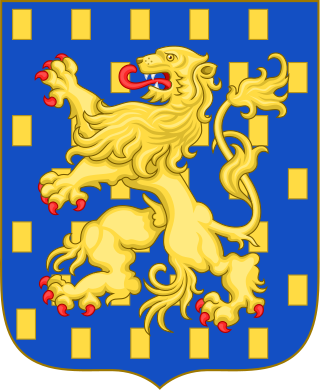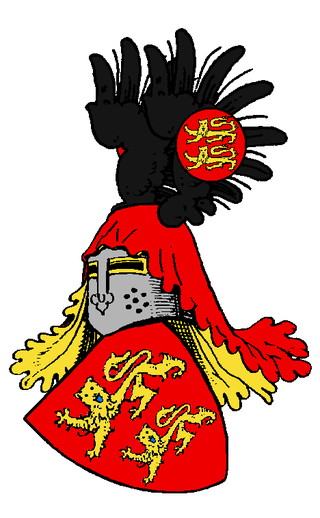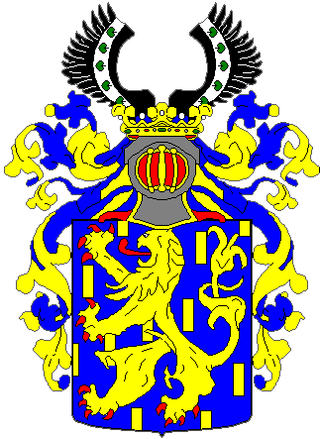
The House of Leiningen is the name of an old German noble family whose lands lay principally in Alsace, Lorraine, Saarland, Rhineland, and the Palatinate. Various branches of this family developed over the centuries and ruled counties with Imperial immediacy.

The House of Nassau is a diversified aristocratic dynasty in Germania. It is named after the lordship associated with Nassau Castle, located in present-day Nassau, Rhineland-Palatinate, Germany. The lords of Nassau were originally titled "Count of Nassau", then elevated to the princely class as "Princely Counts". Early on they divided into two main branches: the elder (Walramian) branch, that gave rise to the German king Adolf, and the younger (Ottonian) branch, that gave rise to the Princes of Orange and the monarchs of the Netherlands.
Frederick III of Nuremberg, Burgrave of Nuremberg from the House of Hohenzollern, was the eldest son of Conrad I of Nuremberg and Adelheid of Frontenhausen.
Otto I of Nassau, German: Otto I. von Nassau was Count of Nassau and is the ancestor of the Ottonian branch of the House of Nassau.
Nassau-Siegen was a principality within the Holy Roman Empire that existed between 1303 and 1328, and again from 1606 to 1743. From 1626 to 1734, it was subdivided into Catholic and Protestant parts. Its capital was the city of Siegen, founded in 1224 and initially a condominium jointly owned by the archbishopric of Cologne and Nassau. It was located some 50 km east of Cologne, and it contained the modern localities of Freudenberg, Hilchenbach, Kreuztal, Siegen, and Wilnsdorf.

Waldbrunn (Westerwald) is a municipality in Limburg-Weilburg district in Hesse, Germany.

John I of Isenburg-Limburg, "The blind Lord" was from 1289 Count of (Isenburg-) Limburg and the head of the House of Limburg. The core territory of the Lordship of Limburg consisted of the city of Limburg an der Lahn and several surrounding villages.

The County of Leiningen consists on a group of counties, which were ruled by the Leiningen family.

Count John I of Nassau-Siegen, German: Johann I. Graf von Nassau-Siegen, was since 1362 Count of Nassau-Siegen. He descended from the Ottonian Line of the House of Nassau.

Count Otto II of Nassau-Siegen, German: Otto II. Graf von Nassau-Siegen, was since 1343 Count of Nassau-Siegen. He descended from the Ottonian Line of the House of Nassau.

Henry I of Nassau-Siegen, German: Heinrich I. von Nassau-Siegen was Count of Nassau-Siegen, a part of the County of Nassau, and ancestor of the House of Nassau-Siegen. He comes from the Ottonian branch of the House of Nassau.
Christian, Prince of Nassau-Dillenburg was the last ruler of Nassau-Dillenburg from the line that had started in 1606 with George, Count of Nassau-Dillenburg.

Francis Alexander von Nassau-Hadamar was the last prince of Nassau-Hadamar.
John, Count of Nassau-Dillenburg was the third son of Count Otto I of Nassau and his wife Agnes, daughter of Count Emich IV of Leiningen-Landeck. John was a first cousin of King Adolf of the Romans.

The County of Diez was a county of the Holy Roman Empire, centred on the Grafenschloss at Diez in Lahngau. The county is first attested in 1073 and seems to have been created from the territory of the Conradine dynasty after they relocated to Swabia. The Counts rose to prominence in the second half of the twelfth century as close partisans of the Hohenstaufen dynasty. During this period, it was known as the "Golden County".

Philip III of Falkenstein, Lord of Falkenstein, Münzenberg and Lich, Hesse was a member of the Lich line of the Falkenstein dynasty, son of Werner I of Falkenstein, Lord of Münzenberg and Falkenstein, who founded the Lich line, and his wife Mechtild of Diez.

Nassau-Hadamar is the name of two side lines of the Ottonian main line of the House of Nassau. The older line of the counts of Nassau-Hadamar existed from 1303 to 1394; the younger line existed from 1607 to 1711 and received the hereditary title of prince in 1652.

Lichtenstein Castle is a levelled spur castle on the hill of Burgberg Lichtenstein, 315 m above sea level (NN), near the Greifenstein village of Holzhausen on the old military High Road, that ran from Frankfurt via Wetzlar to Cologne. The castle site is situated to the north of, and above, the Ulmbach Reservoir in the Hessian county of Lahn-Dill-Kreis.
Agnes of Leiningen was a Countess of Nassau by marriage to Otto I, Count of Nassau. She was probably Regent of the County of Nassau for some time for her youngest son after the death of her spouse in 1289/1290.












